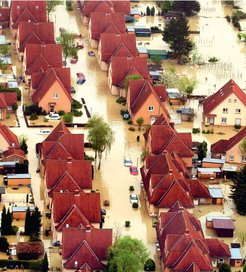The All-in-One Climate Package
by Guy Brasseur and Irene Fischer-Bruns; in: MaxPlanckResearch 4/14

Research into climate change has advanced significantly since the year 2000. By the end of the 20th century, scientists had learned enough about the causes of observable climate change to be able to evaluate the extent to which human actions influence the Earth’s climate. Recently, their focus has shifted to estimating the future consequences of climate change on our interlinked environmental and social systems.
The current trend is to make predictions about the regional consequences of global warming
As a result, the scientific debate now focuses on a range of new and urgent issues, so that the social sciences must now become involved. These new priorities include questions regarding the physical and social vulnerabilities resulting from climate change, the ability to withstand these strains, and the choice between adaptation and prevention strategies. Calls for climate predictions for individual seasons, years and decades are also growing louder – a demand that modern-day science can currently meet only in terms of rough seasonal forecasts in lower latitudes, and even then only in part.
Leaders from the realms of government, public service and private enterprise need reliable climate information based on up-to-date research findings in order to make informed decisions on how to adapt to climate change. The scientific community is perfectly aware of this need, which is why it helps draw up detailed climate reports such as those produced by the Intergovernmental Panel on Climate Change (IPCC), for example. These reports are policy-relevant and form the scientific basis for international negotiations like the UN Framework Convention on Climate Change. Each of these reports takes several years to prepare.
The task of enabling knowledge transfer isn’t an easy one, as there are often conflicts of interest involved. The views and opinions of the scientists are often very different from those of social stakeholders. Even though the scientific community generates sufficient data and users are well informed about the subject matter, large gaps remain when it comes to integrating, analyzing and evaluating the data and translating the results into a context outside the subject area.
As a result, the knowledge gathered by the IPCC is also of only limited use, for example for regional companies, cities and municipalities, as well as for the general public. First and foremost, the IPCC compiles scientific information that is of global relevance, based on global model projections. Like others, however, the IPCC is also experiencing the growing demand for statements about climate consequences, vulnerability and adaptation on a regional scale. A decentralized communication mechanism could be set up to better account for the needs of the decision makers. It must ensure that the research knowledge and the local knowledge of the decision makers – the product of years of experience – complement each other. Climate service providers such as the Climate Service Center in Hamburg are able to implement such a mechanism. As early as 2001, the National Research Council (NRC) of the American Academy of Sciences defined the term climate service as “the timely production and delivery of useful climate data, information and knowledge to decision makers.” The report states that an improved information management system is necessary for the advancement of measures relating to climate change.
Public opinion has a major influence on political decision-making
In a later report, the NRC recommends developing a comprehensive greenhouse gas monitoring and management system that is coordinated by climate service institutions. Again, there was a call for customized information that must be made available to the social interest groups. According to the NRC, the key functions of climate service providers include expanding monitoring systems, intensifying efforts to develop vulnerability analyses on a regional scale, sustainably interacting with all participating actors, conducting new kinds of research to assess demand, and utilizing a suitable communication strategy.
The task that climate service providers are expected to perform therefore goes far beyond the mere production of knowledge. They must develop product prototypes, meaning new, research-based and customized information and methods that are produced and tested for feasibility together with the users. They support the decision-making process, for example when identifying measures to adapt to climate change.
The product prototypes are created using a top-down approach, but they also require extensive interaction (bottom-up) with the respective stakeholders so that hands-on experience can be incorporated into the process. The top-down approach is based on climate projections and takes into account the corresponding uncertainties. The bottom-up approach refers to analyses that evaluate the effects of climate change on socio-ecological systems. The innovative task of climate service providers is to combine both of these approaches.
In so doing, climate service institutions can eliminate a deficit of the past, as efforts to communicate knowledge on climate change have often failed in recent decades. Even though the scientific community was able to make steadfast statements regarding important questions about climate change and disseminate them widely (for example via the IPCC reports and the summaries thereof targeted at decision makers), many decision makers remain skeptical and show no signs of changing course in favor of adaptation to climate change.
This inefficient process has several underlying causes. Firstly, individual scientists repeatedly ask critical questions that, if they prove to be justified, could challenge their conclusions. This is actually a healthy process that is common in many different disciplines. Scientifically founded doubts have often set new courses for research and thereby ultimately led to success. Secondly, there are politically motivated individuals who unnecessarily exaggerate the uncertainties communicated by the scientific community. Their goal is to set up “orchestrated campaigns” that cast doubt on the quality of work and the integrity of the international scientific community – often with the financial backing of large international corporations and politically motivated groups. After all, the press – always in search of controversial headlines – is often tempted to give statements made by the majority of international scientists the same weight as frequently unfounded statements made by a very small minority. This causes great confusion among the general public, because the population isn’t able to weigh up the scientific facts or analyze in detail the quality of the information that is spread.
Public opinion has a major influence on the decisions made by government officials and politicians. Citizens absolutely are interested in climate change – they are, after all, often directly affected by it. Their views on this subject depend largely on the statements made by scientists – but not exclusively, because each person is also significantly shaped by societal beliefs (especially religious and family values), as well as by the individual’s personality structure. Likewise, their perceptions are influenced by the currently dominating social structures, political systems and economic values. In addition, they are exposed to confusing messages disseminated by the media.
Complicated knowledge about the Earth’s climate can therefore be conveyed only by developing communication strategies that can do justice to the overall complexity and multidimensional character of this subject matter. That goal requires laborious dialog processes that go far beyond classic knowledge transfer, where information is typically passed on from so-called experts to so-called laypersons.
The type of information that needs to be communicated is also an important factor. Only a small number of interest groups actually require original data, such as the information that hydrometeorological service institutions draw from scientific databases. What most practitioners need are analyses and expert opinions that link this data with specific, local knowledge about new insights. Many questions refer to very specific situations, special regions and particular local conditions. It is imperative to also be familiar with the social, economic and cultural circumstances of such a region, and to form a network with the actors there, both on a local and on a national level.
Customer-specific climate services can gain trust only if they remain impartial
Despite significant advances in science, this kind of application-oriented knowledge about the Earth’s climate and climate change wasn’t yet available to the public at the start of the last decade. That’s why, in 2007, the German federal government decided to set up a German Climate Service Center designed to bridge the gap between climate research and the general public. Initially envisioned as a five-year project in 2009, it has since become a permanent institution at the Helmholtz-Zentrum Geesthacht. It complements the existing range of institutions that have been successfully providing climate services in Germany for many years, including the Deutscher Wetterdienst (German Meteorological Service), the Regional Climate Offices of the Helmholtz Association of German Research Centers (HGF), and KomPass, the Climate Impacts and Adaptation in Germany initiative sponsored by the Federal Environment Agency.
Many new climate service institutions are also being set up on an international level. The European Centre for Medium-Range Weather Forecasts (ECMWF), for example, is currently developing a service structure for climate and adaptation services, as well as a comprehensive database. And the European Environment Agency (EEA) in Copenhagen is setting up a platform designed to help countries and municipalities devise adaptation strategies.
The EU Research Framework Program Horizon 2020 sponsors projects that aim to disseminate climate information. The European Joint Programming Initiative (JPI) Climate, comprising 14 member states, seeks to improve the coordination processes between national and European climate research efforts. Climate-KIC, a major EU climate innovation initiative, is already involving European businesses in its activities. These are just a few examples from a long list of European initiatives in this field.
In addition, most countries in Europe and elsewhere in the world have established climate service institutions with a broad range of functions and tasks. Global network initiatives have also been developed. The goal of the UN-wide Global Framework for Climate Services (GFCS), which was set up by the World Meteorological Organization (WMO), is to foster the global exchange of knowledge about climate change.
Climate service providers face a large number of challenges. They must remain impartial and neutral, shouldn’t let their actions be dictated by interests, and should use high-quality basic data and methods. Only then will users trust their products. Industry- and sector-specific risks and opportunities that arise from climate change must be mastered in unison with the relevant actors. The products should be customer-specific and customized in accordance with the respective demand.
Translating research results into practical knowledge is difficult
Even though there are already many institutions that – at least to some extent – offer climate services, there is no universal concept for these types of facilities. It is essential that tasks be clearly divided and that joint initiatives function as planned. In addition, research conducted into the effects of climate change, vulnerability and adaptation must be drastically increased. Apart from developing application-oriented products, climate service providers should also report their users’ existing needs back to the scientists so that their efforts can directly benefit society as a whole.
Gaining a better understanding of the public’s need for climate-change-related knowledge and finding ways to foster productive dialogs between the actors and the science world requires targeted research. However, the scientific community has thus far not fully committed itself to this. Scientists, users and climate service providers should therefore be encouraged to develop products in a joint effort. It is also vital to find effective and objective ways to measure the success of climate services.
Initial experiences have shown that it is difficult to translate research results into practical knowledge that can flow directly into the planning processes of the decision makers. When developing climate services, it is important to identify and link the necessary tasks and factors. Databases containing meteorological, oceanic and hydrological data, as well as re-analyses, model simulations and projections, are indispensable, as is additional data on greenhouse gas emissions, population density, deforestation and urban growth, for example.
Close cooperation between data providers, modelers and hydrometeorological centers is crucial. The ideal solution would be to have these groups work together under the same roof in meteorological centers in order to foster the liaisons between modelers and climate researchers at universities and other scientific institutions. Furthermore, such a facility should also employ a team of communications experts whose main task is to establish connections with potential customers from the various sectors of the economy. The communication experts ascertain their level of demand, answer queries and translate the scientific knowledge into a user-oriented, easy-to-understand format.
Yet climate service institutions don’t just prepare user-specific information and services; they also advise on how to react to climate change in an appropriate manner. That means they also serve as an “adaptation service provider.” First and foremost, this bottom-up approach involves experts from the fields of social, economic and political sciences, as well as engineers. Here, the focus lies primarily on tried-and-tested strategies, solutions and guidelines, as well as on local aspects rather than on global change.
The language used by this scientific community differs from the conventional terminology applied in the natural sciences, which hampers the dialog between the two. Here, it is less about climate predictions and projections, robust results, uncertainties and scenarios, and rather more about vulnerability, resilience, adaptation, governance and international negotiations.
Another key question is whether there is really a market for climate products and services. Once again, experience has shown that large parts of the market still need to be developed. While companies and public services do, in fact, have a need for information on climate change, it isn’t certain whether this need is always recognized.
However, taking a step toward improving cooperation between science and potential users means first having to overcome several obstacles. Firstly, there is a discrepancy between the various time horizons that scientists and decision makers apply to different sectors of society: scientists apply mainly very long-term climate projections, typically spanning the next 50 to 100 years. Entrepreneurs in private corporations and decision makers in public service, on the other hand, require information pertaining to the next five to ten years. That is why it is essential to advance the development of climate predictions on a time scale that spans individual seasons or decades.
Secondly, the business model of most institutions providing climate services doesn’t match that of their customers. It is usually based on contractual relationships, and customers are viewed as subsidizers – by research institutions, for example. However, this model is often incompatible with customer requirements, as the customers expect a very speedy response to their industry-specific queries.
This is where consulting companies from the private sector could serve as a further useful link in the information chain, bridging the gap between scientists and decision makers to help satisfy customer demands. However, these consultants often don’t possess the specific expert knowledge of that particular field, and don’t have close ties to the scientific community, so the services they provide don’t always stand up to the quality expected by science. One solution could be for publicly financed climate service providers to develop prototypical products and then hire a private consulting firm that subsequently sells these products to the societal actors. In doing so, however, the role of these publicly financed institutions would be radically changed, because their primary focus would then no longer lie on communication and information dissemination, but instead on applied research and innovation.
The Authors
Guy Brasseur, born in Belgium in 1948, studied engineering at the Free University of Brussels, where he obtained his doctorate in 1976. Today he is a senior scientist and project leader at the Max Planck Institute for Meteorology in Hamburg, where he previously also served as Director. Furthermore, he was Associate Director at the National Center for Atmospheric Research in Boulder, Colorado (USA). As a scientist, he is particularly interested in atmospheric chemistry, aeronomy of the upper atmosphere, and solar-terrestrial interactions, as well as climate sciences and climate services. From 2009 to 2014, he set up the Climate Service Center of the Helmholtz-Zentrum Geesthacht in Hamburg. He currently holds the position of Chairman of the World Climate Research Programme’s Joint Scientific Committee.
Irene Fischer-Bruns, born in 1956, studied meteorology at the University of Hamburg, where she obtained her doctorate in 1986. As a climate researcher, she was involved in a range of different projects at the university and at the Max Planck Institute for Meteorology, where her main interests included the effect of aerosols on the climate, atmospheric dynamics – particularly in the North Atlantic – and statistics. Starting in 2009, she worked as the scientific assistant to Guy Brasseur for five years, and was involved in setting up the Climate Service Center of the Helmholtz-Zentrum Geesthacht, since renamed Climate Service Center 2.0, where she still works today.












